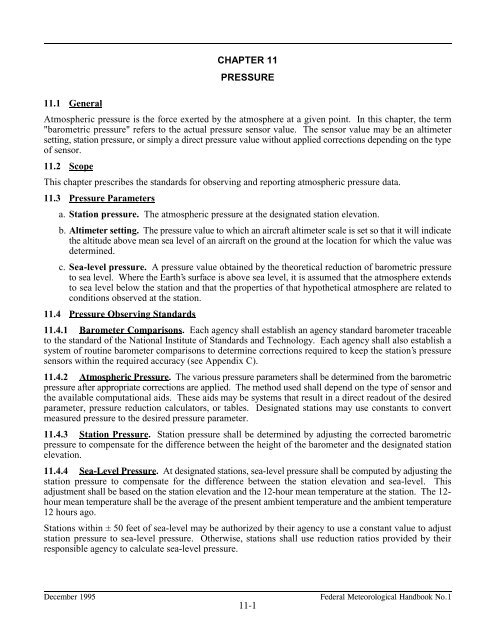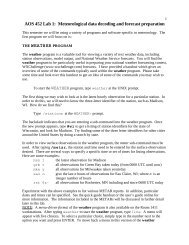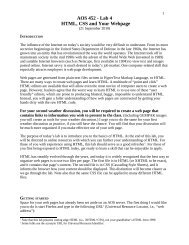Federal Meteorological Handbook No. 1 - Marrella
Federal Meteorological Handbook No. 1 - Marrella
Federal Meteorological Handbook No. 1 - Marrella
You also want an ePaper? Increase the reach of your titles
YUMPU automatically turns print PDFs into web optimized ePapers that Google loves.
11.1 General<br />
CHAPTER 11<br />
PRESSURE<br />
Atmospheric pressure is the force exerted by the atmosphere at a given point. In this chapter, the term<br />
"barometric pressure" refers to the actual pressure sensor value. The sensor value may be an altimeter<br />
setting, station pressure, or simply a direct pressure value without applied corrections depending on the type<br />
of sensor.<br />
11.2 Scope<br />
This chapter prescribes the standards for observing and reporting atmospheric pressure data.<br />
11.3 Pressure Parameters<br />
a. Station pressure. The atmospheric pressure at the designated station elevation.<br />
b. Altimeter setting. The pressure value to which an aircraft altimeter scale is set so that it will indicate<br />
the altitude above mean sea level of an aircraft on the ground at the location for which the value was<br />
determined.<br />
c. Sea-level pressure. A pressure value obtained by the theoretical reduction of barometric pressure<br />
to sea level. Where the Earth’s surface is above sea level, it is assumed that the atmosphere extends<br />
to sea level below the station and that the properties of that hypothetical atmosphere are related to<br />
conditions observed at the station.<br />
11.4 Pressure Observing Standards<br />
11.4.1 Barometer Comparisons. Each agency shall establish an agency standard barometer traceable<br />
to the standard of the National Institute of Standards and Technology. Each agency shall also establish a<br />
system of routine barometer comparisons to determine corrections required to keep the station’s pressure<br />
sensors within the required accuracy (see Appendix C).<br />
11.4.2 Atmospheric Pressure. The various pressure parameters shall be determined from the barometric<br />
pressure after appropriate corrections are applied. The method used shall depend on the type of sensor and<br />
the available computational aids. These aids may be systems that result in a direct readout of the desired<br />
parameter, pressure reduction calculators, or tables. Designated stations may use constants to convert<br />
measured pressure to the desired pressure parameter.<br />
11.4.3 Station Pressure. Station pressure shall be determined by adjusting the corrected barometric<br />
pressure to compensate for the difference between the height of the barometer and the designated station<br />
elevation.<br />
11.4.4 Sea-Level Pressure. At designated stations, sea-level pressure shall be computed by adjusting the<br />
station pressure to compensate for the difference between the station elevation and sea-level. This<br />
adjustment shall be based on the station elevation and the 12-hour mean temperature at the station. The 12hour<br />
mean temperature shall be the average of the present ambient temperature and the ambient temperature<br />
12 hours ago.<br />
Stations within ± 50 feet of sea-level may be authorized by their agency to use a constant value to adjust<br />
station pressure to sea-level pressure. Otherwise, stations shall use reduction ratios provided by their<br />
responsible agency to calculate sea-level pressure.<br />
������������� ������������������������������������<br />
����





